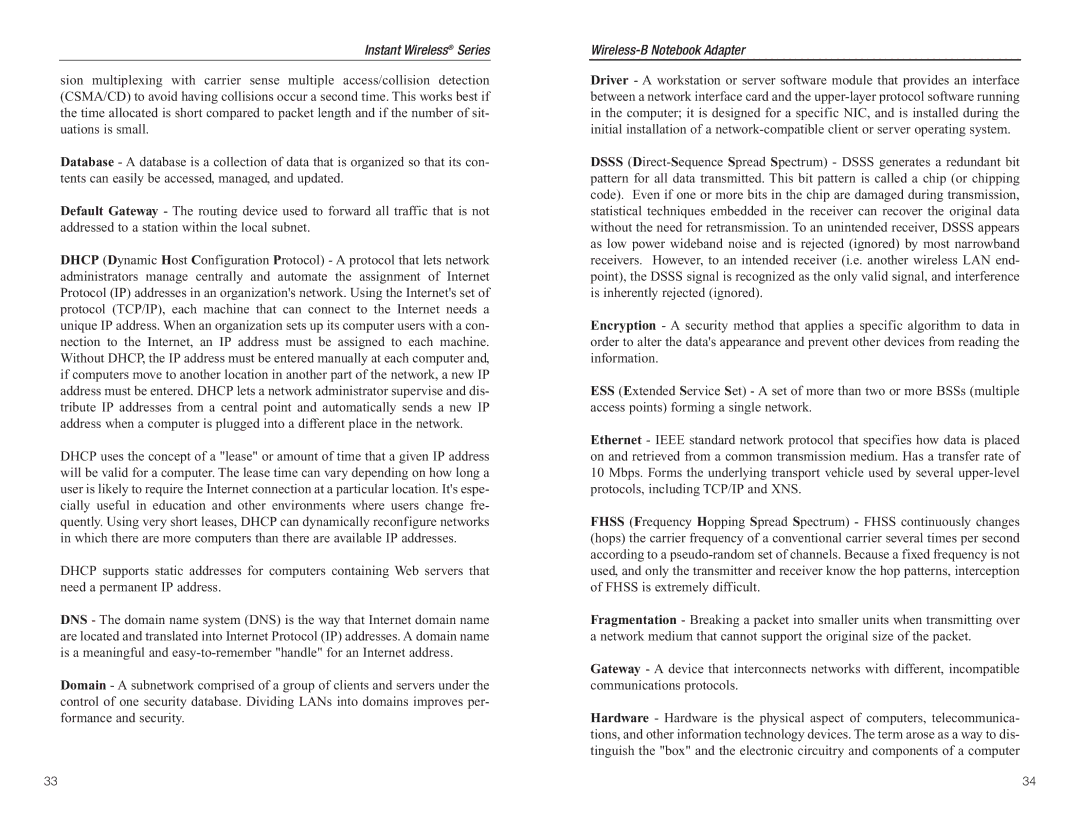Instant Wireless® Series
sion multiplexing with carrier sense multiple access/collision detection (CSMA/CD) to avoid having collisions occur a second time. This works best if the time allocated is short compared to packet length and if the number of sit- uations is small.
Database - A database is a collection of data that is organized so that its con- tents can easily be accessed, managed, and updated.
Default Gateway - The routing device used to forward all traffic that is not addressed to a station within the local subnet.
DHCP (Dynamic Host Configuration Protocol) - A protocol that lets network administrators manage centrally and automate the assignment of Internet Protocol (IP) addresses in an organization's network. Using the Internet's set of protocol (TCP/IP), each machine that can connect to the Internet needs a unique IP address. When an organization sets up its computer users with a con- nection to the Internet, an IP address must be assigned to each machine. Without DHCP, the IP address must be entered manually at each computer and, if computers move to another location in another part of the network, a new IP address must be entered. DHCP lets a network administrator supervise and dis- tribute IP addresses from a central point and automatically sends a new IP address when a computer is plugged into a different place in the network.
DHCP uses the concept of a "lease" or amount of time that a given IP address will be valid for a computer. The lease time can vary depending on how long a user is likely to require the Internet connection at a particular location. It's espe- cially useful in education and other environments where users change fre- quently. Using very short leases, DHCP can dynamically reconfigure networks in which there are more computers than there are available IP addresses.
DHCP supports static addresses for computers containing Web servers that need a permanent IP address.
DNS - The domain name system (DNS) is the way that Internet domain name are located and translated into Internet Protocol (IP) addresses. A domain name is a meaningful and
Domain - A subnetwork comprised of a group of clients and servers under the control of one security database. Dividing LANs into domains improves per- formance and security.
Driver - A workstation or server software module that provides an interface between a network interface card and the
DSSS
Encryption - A security method that applies a specific algorithm to data in order to alter the data's appearance and prevent other devices from reading the information.
ESS (Extended Service Set) - A set of more than two or more BSSs (multiple access points) forming a single network.
Ethernet - IEEE standard network protocol that specifies how data is placed on and retrieved from a common transmission medium. Has a transfer rate of 10 Mbps. Forms the underlying transport vehicle used by several
FHSS (Frequency Hopping Spread Spectrum) - FHSS continuously changes (hops) the carrier frequency of a conventional carrier several times per second according to a
Fragmentation - Breaking a packet into smaller units when transmitting over a network medium that cannot support the original size of the packet.
Gateway - A device that interconnects networks with different, incompatible communications protocols.
Hardware - Hardware is the physical aspect of computers, telecommunica- tions, and other information technology devices. The term arose as a way to dis- tinguish the "box" and the electronic circuitry and components of a computer
33 | 34 |
